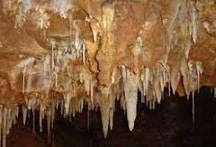The Greek stalaktós , which can be translated as “dripping,” came into scientific Latin as stalactites . This term, in turn, derived in our language from stalactite . This is the name given to the rock that appears on the ceiling of a cave from the filtration of water with particles of calcium carbonate ( calcite ).
 Stalactites are calcareous formations with an irregular structure that end in a point. The water, as it slowly filters from the surface into the interior of the cavern , falls in drops. Each drop that falls drags calcite, causing a kind of cone of this material to gradually form as it solidifies again.
Stalactites are calcareous formations with an irregular structure that end in a point. The water, as it slowly filters from the surface into the interior of the cavern , falls in drops. Each drop that falls drags calcite, causing a kind of cone of this material to gradually form as it solidifies again.
The elongated rocks that seem to hang from the ceiling of a cave are, in short, stalactites. The process of stalactite formation generates, in turn, the appearance of another type of formation: stalagmites .
When water with calcite drips from a stalactite to the floor of the cave, it forms a stalagmite, which is similar to the stalactite although it grows on the ground and with its tip facing upwards.
Although the definition of stalactite refers to water with calcium carbonate, other similar structures can develop with other materials, such as salt or gypsum . There are also lava stalactites or staphylites , which are created by the dripping of residual lava .
Stalactites and stalagmites, in short, develop from the precipitation of minerals that are dissolved in water . The formation process is very slow, since it is linked to changes in the dissolution capacity of water inside the cave, in turn related to the concentration of carbon dioxide in the water and other factors.
It is true that there are many people who tend to confuse stalactites with stalagmites. However, the difference between the two is clear: the former originate from the ceiling and what they do is grow downwards while the latter arise from the ground and grow upwards.
In addition to everything indicated, we cannot ignore the fact that the formation of stalactites is really slow and it is considered that in order for them to grow to around 3 centimeters, it takes between 4,000 and 5,000 years to pass.
Among the most significant stalactites is the largest one located in the famous Caves of Nerja (Málaga). From this it can be indicated that it is about 18 centimeters in diameter, that it is 60 meters high and that it has an age that is established around 450,000 years.
However, we should not overlook stalactites of great value and beauty, such as those in the El Soplao Cave, in Cantabria, or those in the Cuevas del Drach, which are located on the island of Mallorca.
In the same way, we cannot ignore the existence of a song that has the term in question in its title. We are referring to “Estalactitas”, which is composed and performed by the Uruguayan artist Jorge Drexler. It was published in 2017 and is part of the album “Salvavidas de ice”.
